The Closest Planet to the Sun is not THAT HOT - MERCURY
While piecing together a post on the hottest planet in the Milky Way galaxy, which by the way is Venus, a planet that is in the second position away from the Sun. I couldn’t help but wonder why the reputation of the planet with the most hellish temperature didn’t go to the planet facing the Sun directly - Mercury. I was intrigued to find out more about Mercury, and why it missed out on being the hottest planet in the solar system, despite the Sun being in close proximity. I came across a couple of interesting reasons, and I hope to briefly explain them in this post, as well as other amazing facts about this cute little planet.
Mercury got its name from the Romans, named after a fast-footed messenger god. This is due to Mercury’s swift orbit around the Sun, which is the fastest in comparison to the other planets in the solar system. Mercury is sometimes connected to the god best known for writing, called Nabu. And Greek astronomers have been known to have given Mercury separate names as both the morning and evening star.
This is why I’m HOT
Despite the Sun's close presence, Mercury’s temperature is a couple of notches lower when compared to Venus. Don’t be mistaken, during the day, Mercury is terribly hot, its temperature is so high, it can melt lead, tin and zinc. But the reason Mercury isn’t hotter than Venus despite how close the Sun is to Mercury is that, unlike Venus, Mercury lacks an atmosphere, and an atmosphere traps and hold heat. Meaning, the heat Mercury get directly from the Sun, is promptly lost back into space.
Venus on the other hand possesses a thick atmosphere, that consists of carbon dioxide. This makes the surface of the planet extremely hot because the heat cannot escape back into space.
Mercury's Physical Properties
Due how close the Sun is to Mercury, the temperature at the surface can get as high as 450oC (840oF). But due to its lack of an atmosphere that could help in trapping some of the heat derived from the Sun, the temperatures at night can plunge to -275oF (-170o) making this the greatest temperature swing in the entire solar system 1,100oF (600oC)
Widely known as the smallest planet in the entire solar system, even, Jupiter and Saturn are said to have moons bigger than Mercury. Not only is the planet small, it continues to shrink as it has in it the past. The little planet comprises of one continental plate positioned above a chilling iron core. This core solidifies due to the cooling effect of the iron core, which in turn reduces the planet’s size by means of shrinking. This activity crushes the surface, making cliffs and scarps that are lope shaped, that extends for several miles, possibly hundreds, and reaching a mile in height. Not to mention the planet’s ‘Great Valley’ that measures up to 250 miles in width, 620 miles in length, & 2 miles in depth. Making it larger than the Grand Canyon.
Due to high volcanic activities, in the past, the planet’s surface was continually reshaped, although recent studies suggest that volcanic eruptions in Mercury ended over 3.4 billion years in the past.
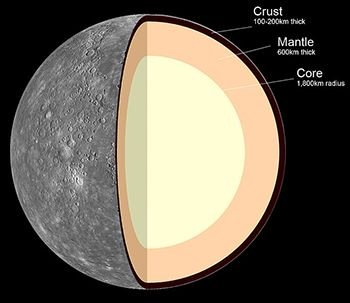
Internal structure of Mercury by Jcpag2012 with Creative Commons Attribution-Share Alike 4.0 International license.
Earth is the densest planet, in the galaxy, second to Mercury, which some know possesses a massive metallic core. Estimated to be about 3,600 - 3, 800 km (2,200 - 2,400 miles) in the width which accounts for roughly 75% of Mercury’s diameter. In comparison to the planet’s outer shell which measures at 500 - 600 km (300 - 400 miles) in thickness.
Despite Mercury possessing the equivalent of just 1% of Earth’s magnetic field, which is active. The Solar wind has a magnetic field - which is charged particles surging from the sun. These particles frequently touch Mercury’s magnetic field, this creates strong magnetic tornadoes, which channels solar wind’s hot and fast plasma down to Mercury’s surface.
Orbital Characteristics
It takes just eighty-eight Earth days for Mercury to complete an orbit round the Sun, moving across space at 180,000km/h (112,000mph) quicker than all the planets in the solar system.
Its oval-shaped orbit is highly elliptical, taking Mercury as close as 47 million Km (29 million miles) and as far as 70 million km (43 million miles) from the Sun. If you stand on Mercury when the Sun is nearest to it, it would appear more than three times as large as it does when viewed from Earth. - “Space.com”
Due to Mercury’s highly elliptical orbit and the 59 Earth - days, it takes to rotate on its axis when on the scorching surface of the planet, the sun appears to rise briefly, set, and rise again before it travels westward across the sky. At sunset, the sun appears to set, rise again briefly, and then set again - space.com
Mercury’s Structure and Composition
NASA termed Mercury’s atmosphere is “Surface-bound exosphere” which basically means - vacuum. It is made up of 42% oxygen, 29% sodium, 22% hydrogen, 6% helium,.5% potassium, including traces of water, carbon dioxide, xenon, argon, krypton, nitrogen and neon.
Internal structure: Made of an estimated 3,600 - 3,800km (2,200 - 2, 400 miles) wide. Outer shell is estimated at 500 - 600 km (300 - 400 miles) thick.
Magnetic field: Estimated 1% of the strength of Earth’s
Exploration and Research
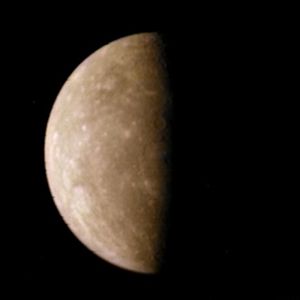
Image - Wikimedia Commons
Mercury in real colours, processed from clear and blue filtered Mariner 10 images.
In 1974, NASA’s Mariner 10 was the first space vessel to visit the planet, it took almost 3,000 images of about 45% of Mercury’s surface, and also detected the presence of a magnetic field. Almost 30 years later, NASA’s orbiter - the MESSENGER was inaugurated on August 3rd, 2004; it became the second space vessel to visit the planet.
MESSENGER (MErcury Surface, Space ENvironment, GEochemistry, and Ranging)
March 2011, the MESSENGER finally arrived Mercury, becoming the first space vessel to orbit the planet. The MESSENGER mission was suddenly ended on 30th April 2015, when it exhausted its fuel and crashed into Mercury’s surface.
A discovery was made In 2012 when scientists uncover a variety of meteorites found somewhere in Morocco, which they believe could be from Mercury. If this proves to be true, it will make Mercury a comrade of the exclusive solar bodies, with samples present on planet Earth. A club that has Mars, the moon, as well as the main asteroid belt with verified rocks.
References
SPACE.COM | Facts About the planet closest to the Sun
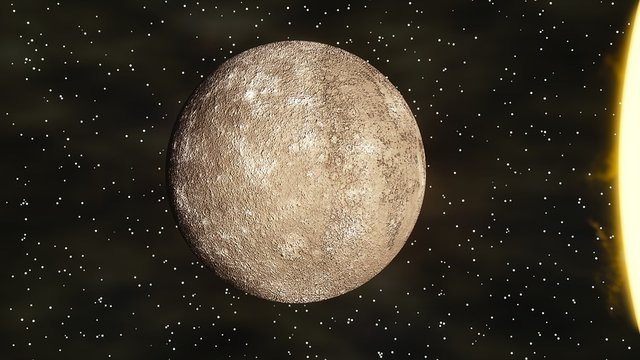
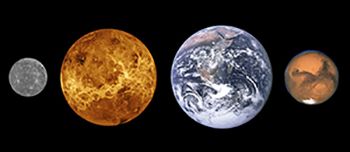
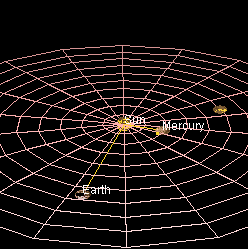

Ive always hear this fact but only understood why now. Really amazingly written.
Many thanks
@agbona, this is a very captivating article. I personally love to read about astronomy and i find this a good read.
It is a good thing how nature has designed our own habitat. Thanks, to the cloak (atmoshphere) over in the sky and the presence of greenhouse gases in it. Otherwise our case wouldn't be that different from that of Mercury or even our own moon.
But the bad news now is that we generate more heat and greenhouse gases artificially which has been doing some harm to our ecosystem. However, i hope the advent of various green technology can get us what we have lost.
Your analysis is spot on
Humanity needs to find a viable way around the generation and consumption of energy, but even at that, the demise of our kind is inevitable. I wrote a post on the possible ways the universe will get destroyed.
Although the points mentioned are just theories, if events continue to unfold as predicted, in the distant future, everything will get destroyed, and our technology won't be able to help us.
Science is scary!
Cool! I didn't know about this one. If you would have asked me the question, I would have been wrong :D
Oh wow!
Glad you found it educative.
You received a 60.0% upvote since you are a member of geopolis and wrote in the category of "geology".
To read more about us and what we do, click here.
https://steemit.com/geopolis/@geopolis/geopolis-the-community-for-global-sciences-update-4
Wow... Its like i have just been struck by lightning.. Venus the hottest. Hmm
Nice one
The same thing I thought bro, Venus hotter than Mercury, the Sun's next door neighbour ...
I would have failed if this is a question to win 1 million dollars.
Let me sound like an ignorant Nigerian mum
You will not fail in Jesus name!
Hehehe... Amen!
@resteemator is a new bot casting votes for its followers. Follow @resteemator and vote this comment to increase your chance to be voted in the future!
Maybe not as how as we would expect, but still very hot though! But thanks for making a great post, @agbona! I did't know much about Mercury to begin with, so I learned some interesting stuff from this :) Keep it up!
You're right, Mercury is not as hot as we will expect it, but its temperature can plunge from 450oC during the day, to -173oC at night. making it the greatest temperature swing in the entire solar system.
So that's why Venus is hotter than Mercury. It's because of Mercury's absence of having an atmosphere of it's own. I've learned something great today thanks to @agbona.

Am glad you find the post educative...
The closest but not the hottest!
To me, even its speed would also make it cool faster.
That's an interesting point, very quite valid point. Thanks for the contribution.